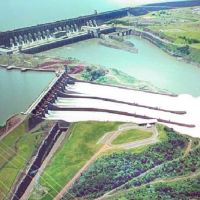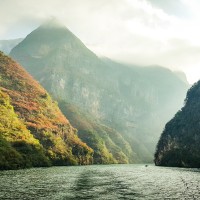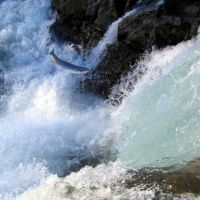Conservation and restoration of riparian zones under multiple pressures

Riparian zone around Burns Run, Clinton County, Penn, USA. Image: Nicholas A. Tonelli | Flickr Creative Commons
Conservation efforts to maintain and restore riparian zones along many global rivers are often inadequate, according to a new study. Writing in the journal Biological Conservation, Eduardo González and colleagues draw on a body of emerging research on riparian zones to identify a range of ecological, socio-economic and policy pressures for their fragmented distributions.
Riparian zones are the ecosystems found along the banks of rivers and streams: narrow transitional zones between land and water, often with diverse ecosystems that play important roles in the ecological functioning of the wider landscape. Riparian zones – often dominated by tree and plant species which thrive in damp conditions – can help buffer diffuse pollution, mitigate flood risks, store carbon, reduce bank erosion, provide shaded and cool stream water, prevent livestock from trampling fish spawning grounds, and offer valuable biodiversity habitat.
However, riparian zones have been under pressure in many rivers across the world for decades, if not centuries. Floodplains have been widely built upon, river channels straightened and reinforced, hydrology patterns altered by dam building, and riparian woodland cleared in many landscapes. González and colleagues cite studies stating that up to 90% of North American and European floodplains are considered ‘ecologically dysfunctional’, and in Europe up to 88% of floodplain forests have disappeared, as a result of human activity.

Cheonggyecheon stream and new ‘riparian zone’ in Seoul, South Korea, daylighted from sewers in 2003. Image: Kaizer Rangwala, Flickr Creative Commons
Riparian zone restoration is an important part of many ongoing river basin management strategies, with some notable successes (see, for example the restoration of the Truckee River in Nevada, USA). However, González and colleagues identify three barriers to successful riparian zone management. The first barrier is ecological: some riparian ecosystems are so highly altered that they may not be able to respond positively to conservation initiatives (as this study outlines).
The second barrier is socio-economic: where societies prioritise floodplain development and flood defences over the potential (perhaps sometime poorly communicated) ecosystem services and benefits that riparian zones may generate. The third barrier is the structure of policy systems in which environmental goals may be marginalised by economic or social imperatives. The complexity of such policy barriers are clearly outlined in the following passage from the study:
One of the problems associated with the lack of formal recognition of riparian zones is that the application of individual policies can have antagonistic effects. For example, in Europe, young cohorts of poplar and willow trees are frequently removed under the Flood Risk Directive to avoid vegetation encroachment and increase stream conveyance capacity (Geerling et al., 2008), while these same species are being promoted by the Habitats Directive to preserve alluvial forests (Hughes and Rood, 2003) and create ecological networks along river corridors (Jongman et al., 2004). The creation and maintenance of alluvial forests are also supported by the European Agricultural Funds for Rural Development and enforced by the cross-compliance regulation as one strategy to achieve vegetated buffer zones along rivers (Gumiero et al., 2016).
In common with every modern-day environmental issue, we might add in climate change as a fourth key barrier to riparian zone conservation. Hydrology alterations, increased droughts in some regions, and floods in others, changes to species habitat niches and biological invasions and extinctions are all projected to occur under global climatic change over coming decades (see this analysis of climate change and riparian zone vegetation for more information).

A diverse riparian zone along a river in the Rif region of Morocco. Image: Nuria Bonada
In order to navigate this complicated landscape, the authors argue that riparian zone management is in need of integrated approaches that promote and restore the value of these unique ecosystems. González and colleagues sketch a model for such integrative riparian zone management, based on five themes: education, inventory, protection, sustainable management, and restoration.
Expanded and effective education schemes about the value and aesthetics of well-functioning riparian ecosystems are advocated by the authors, whether through NGO outreach, citizen science initiatives or national education policies. In many urbanised and agricultural landscapes, there may be a ‘shifted baseline‘ in environmental perception which means that many people may be unaware of historical riparian zones in their local landscapes. Such education work may thus form the groundwork for generating popular support for riparian conservation and restoration.
Whilst it may sometimes seem like humans have mapped and measured every inch of the world, there are still ecosystems in even highly populated areas that are still only partially understood and monitored by scientists. Riparian zones are one such ecosystem type: they cover vast distances, cross political and environmental boundaries, and can be highly dynamic over seasons. As such, developing long-term environmental inventory and monitoring schemes can help inform and prioritise riparian conservation and restoration, and provide a stronger scientific base for influencing policy decisions.

Room for biodiversity, heritage and art along the Water of Leith riparian corridor in urban Edinburgh, Scotland. Image: Saskia Heijltjes | Flickr Creative Commons
The final three themes of González and colleagues’ management proposal are linked aspects of conservation: protection, sustainable management, and restoration. In some areas, protection through restricting activities such as livestock grazing or agricultural production is highly effective in promoting riparian regrowth.
In others, engaging local communities with the sustainable shared use of riparian zones is key, for example through ‘green corridor’ riparian zones along urban rivers (such as on the Water of Leith in Edinburgh). In some areas, this may involve the use policy incentives such as payments for ecosystem services or agri-environmental schemes to promote riparian zone conservation and compensate for the loss of potentially valuable land. The authors advocate that all economic activities in riparian zones should be run on sustainable management principles.
Riparian restoration is a core element of many river basin management plans across the world. González and colleagues highlight a key challenge for such restoration: many riparian zones have been so highly modified that it is difficult to return ecological conditions and processes to a pre-modification ‘reference’ state. Where riparian zones have been lost as the result of the construction of a small dam or flood walls, the subsequent removal of such structures may allow for “room for the river” to be restored. In many cases, though, the active transformation of riparian land through alterations to river hydrology and environmental flows, tree-planting, control of grazing, or ceasing of agricultural production is necessary. For the authors, such restoration processes require clear, realistic, multi-scale and evaluable goals.
Riparian zones are valuable land to many individuals, both human and non-human. To humans, they provide the space to access, use and enjoy waterways, and fertile and often aesthetically pleasing land for development and production. For plants and animals, riparian zones are often diverse and valuable habitats, which in turn can generate a broad range of ecosystem services.
As such, they are always likely to be contentious spaces for management, planning and policy, particularly when the uncertainties of flooding and climate change (and their subsequent management and mitigation) are brought into decision-making processes. Whilst González and colleagues’ paper doesn’t necessarily offer any new information, it provides a valuable and clear-headed review and synthesis of the existing research in the field, which will likely help extend and develop current debates in riparian zone management and policy.














